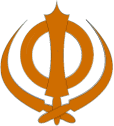Frequently Asked Questions
To address misconceptions surrounding the Sikh culture, we have compiled a regularly updated resource to answer common questions. This page serves as a reliable and growing repository of information, providing accurate insights into Sikhism.
Q1: Why is killing of animal typically a male goat in the Jhatka tradition is acceptable in Sikh tradition?
Ans: Jhatka is the process of decapitating the head of an animal preferably a male bakra (goat), whilst Chandi di Vaar, a bani from Sri Dasam Guru Granth Sahib Ji, is recited. On hearing the final words of this bani (Fir Na Jooni Aiya) the head is decapitated in one strike (Jhatka-Gatka).
ਫੇਰਿ ਨ ਜੂਨੀ ਆਇਆ ਜਿਨਿ ਇਹ ਗਾਇਆ ॥੫੫॥
And that person who sings it (Chandi Di Vaar), Will not take birth again.55
Ang 325, Sri Dasam Guru Granth Sahib
Jhatka is not for fulfilling one’s desire or taste. Maharaj illustrates this as a characteristic of the supreme Jogani (Chandi) within Ath Chandi Charitar Ustat Barananan.
ਭਰੇ ਜੋਗਨੀ ਪਤ੍ਰ ਚਉਸਠ ਚਾਰੰ ॥
Bharai Joganee Pattar Chausatt Chaaran
Q2: What does 96 Krori imply?
Ans: 96 Krori is believed to be the count of Shahid Singhs who are going to reincarnate in future and establish Sikh Kingdom. Please have a look at the video below by Mahant Tarlochan Singh Ji Head Granthi Tarna Dal Baba Bakala Sahib:
Q3: What is Dussehra Mahatam? How it is relevant to Sikh culture?
Ans: During the time of Dussehra celebration, people used to celebrate this festival by staging plays of the Ramayana for nine consecutive nights. However, Sri Guru Gobind Singh Ji, in his wisdom, diverted the Khalsa from such practices and transformed it into nine nights of reciting Bir Ras and Judh Mai Bani (imbued with the spirit of warriors). By refocusing the festival on 'Shastar' (weapons) and 'Shaastar' (Gurbani), Guru Sahib instilled a sense of 'Chardi Kala' and 'Bir Ras' (warrior spirit) within his Sikhs.
Rather than having the Sikhs passively witness plays depicting the defeat of demons like Ravan, Meghnaad, and Kumbhkaran, Guru Sahib instead recited tales of Dharam Yudh (the battle for righteousness) to ignite the warrior spirit in the Bani of 'Raam Avtar'. He instructed the Sikhs to read this Bani during the period of Dussehra. Upon completing the Paath, Guru Sahib would lead a grand procession called 'Mahalla,' which included Nishan Sahibs (religious flags), the beats of battle drums, and Sikhs demonstrating martial arts.
One of the very important path of these 9 days of event is Aarti Aarta which is sung daily throughout these 9 days. Please have a look at the videos below for previous year celebrations of this event:
-
Dussehra Mahatam full path 2022: by Shromani Panth Akali Budha Dal Canada : https://www.youtube.com/watch?v=_065llDAzdI
-
Aarti Aarta 2020: by Dal Panth BC, 2020: https://www.youtube.com/watch?v=mTBOkW-Uyws
-
Aarti Aarta 2018: by DalPanth Toronto : https://www.youtube.com/watch?v=z5-VB_ClgDw

